maven 構建配置文件
構建配置文件是一系列的配置項的值,可以用來設置或者覆蓋 maven 構建的默認值。
使用構建配置文件,你可以為不同的環境,比如說生產環境和開發環境,定制構建方式。
配置文件在 pom.xml 文件中使用 activeprofiles 或者 profiles 元素指定,并且可以通過各種方式觸發。配置文件在構建時修改 pom,并且用來給參數設定不同的目標環境(比如說,開發、測試和生產環境中數據庫服務器的地址)。
1. 構建配置文件的類型
構建配置文件大體上有三種類型:
| 類型 | 在哪定義 |
|---|---|
| 項目級(per project) | 定義在項目的pom文件pom.xml中 |
| 用戶級 (per user) | 定義在maven的設置xml文件中 (%user_home%/.m2/settings.xml) |
| 全局(global) | 定義在 maven 全局的設置 xml 文件中 (%m2_home%/conf/settings.xml) |
2. 配置文件激活
maven的構建配置文件可以通過多種方式激活。
- 使用命令控制臺輸入顯式激活。
- 通過 maven 設置。
- 基于環境變量(用戶或者系統變量)。
- 操作系統設置(比如說,windows系列)。
- 文件的存在或者缺失。
3. 配置文件激活范例
假定項目結構如下:
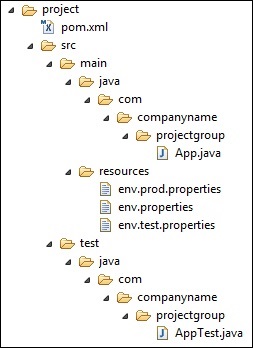
其中在src/main/resources文件夾下有三個用于測試文件:
| 文件名 | 描述 |
|---|---|
| env.properties | 如果未指定配置文件時默認使用的配置。 |
| env.test.properties | 當測試配置文件使用時的測試配置。 |
| env.prod.properties | 當生產配置文件使用時的生產配置。 |
注意:這三個配置文件并不是代表構建配置文件的功能,而是用于本次測試的目的;比如,我指定了構建配置文件為 prod 時,項目就使用 env.prod.properties文件。
注意:下面的例子仍然是使用 antrun 插件,因為此插件能綁定 maven 生命周期階段,并通過 ant 的標簽不用編寫一點代碼即可輸出信息、復制文件等,經此而已。其余的與本次構建配置文件無關。
1) 配置文件激活
profile 可以讓我們定義一系列的配置信息,然后指定其激活條件。這樣我們就可以定義多個 profile,然后每個 profile 對應不同的激活條件和配置信息,從而達到不同環境使用不同配置信息的效果。
以下實例,我們將 maven-antrun-plugin:run 目標添加到測試階段中。這樣我們可以在不同的 profile 中輸出文本信息。我們將使用 pom.xml 來定義不同的 profile,并在命令控制臺中使用 maven 命令激活 profile。
pom.xml 文件如下:
<project xmlns="http://maven.apache.org/pom/4.0.0" xmlns:xsi="http://www.w3.org/2001/xmlschema-instance"
xsi:schemalocation="http://maven.apache.org/pom/4.0.0 http://maven.apache.org/maven-v4_0_0.xsd">
<modelversion>4.0.0</modelversion>
<groupid>com.jsoft.test</groupid>
<artifactid>testproject</artifactid>
<packaging>jar</packaging>
<version>0.1-snapshot</version>
<name>testproject</name>
<url>http://maven.apache.org</url>
<dependencies>
<dependency>
<groupid>junit</groupid>
<artifactid>junit</artifactid>
<version>3.8.1</version>
<scope>test</scope>
</dependency>
</dependencies>
<profiles>
<profile>
<id>test</id>
<build>
<plugins>
<plugin>
<groupid>org.apache.maven.plugins</groupid>
<artifactid>maven-antrun-plugin</artifactid>
<version>1.8</version>
<executions>
<execution>
<phase>test</phase>
<goals>
<goal>run</goal>
</goals>
<configuration>
<tasks>
<echo>using env.test.properties</echo>
<copy file="src/main/resources/env.test.properties" tofile="${project.build.outputdirectory}/env.properties" overwrite="true"/>
</tasks>
</configuration>
</execution>
</executions>
</plugin>
</plugins>
</build>
</profile>
<profile>
<id>normal</id>
<build>
<plugins>
<plugin>
<groupid>org.apache.maven.plugins</groupid>
<artifactid>maven-antrun-plugin</artifactid>
<version>1.8</version>
<executions>
<execution>
<phase>test</phase>
<goals>
<goal>run</goal>
</goals>
<configuration>
<tasks>
<echo>using env.properties</echo>
<copy file="src/main/resources/env.properties" tofile="${project.build.outputdirectory}/env.properties" overwrite="true"/>
</tasks>
</configuration>
</execution>
</executions>
</plugin>
</plugins>
</build>
</profile>
<profile>
<id>prod</id>
<build>
<plugins>
<plugin>
<groupid>org.apache.maven.plugins</groupid>
<artifactid>maven-antrun-plugin</artifactid>
<version>1.8</version>
<executions>
<execution>
<phase>test</phase>
<goals>
<goal>run</goal>
</goals>
<configuration>
<tasks>
<echo>using env.prod.properties</echo>
<copy file="src/main/resources/env.prod.properties" tofile="${project.build.outputdirectory}/env.properties" overwrite="true"/>
</tasks>
</configuration>
</execution>
</executions>
</plugin>
</plugins>
</build>
</profile>
</profiles>
</project>
注意:構建配置文件采用的是 <profiles> 節點。
說明:上面新建了三個 <profiles>,其中 <id> 區分了不同的 <profiles> 執行不同的 antrun 任務;而 antrun 的任務可以這么理解,antrun 監聽 test 的 maven 生命周期階段,當 maven 執行 test 時,就觸發了 antrun 的任務,任務里面為輸出文本并復制文件到指定的位置;而至于要執行哪個 antrun 任務,此時構建配置文件起到了傳輸指定的作用,比如,通過命令行參數輸入指定的 <id>。
執行命令:
mvn test -ptest
提示:第一個 test 為 maven 生命周期階段,第 2 個 test 為構建配置文件指定的 <id> 參數,這個參數通過 -p 來傳輸,當然,它可以是 prod 或者 normal 這些由你定義的<id>。
運行的結果如下:
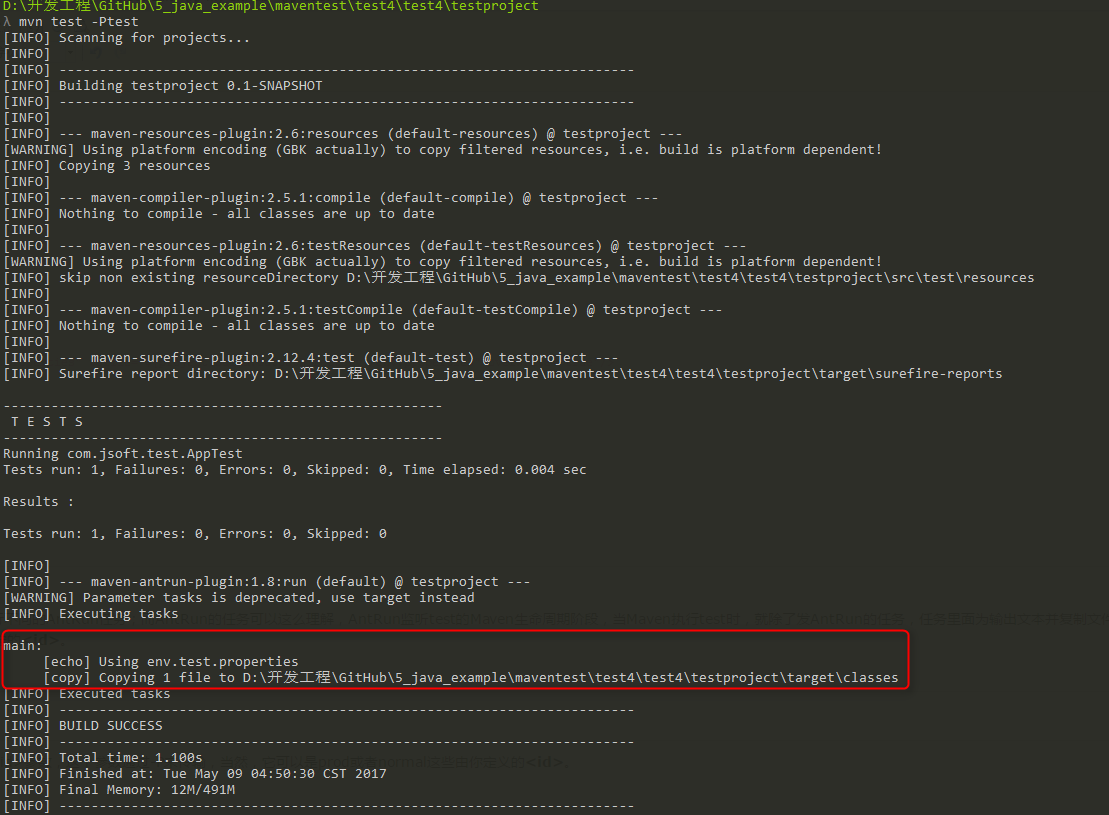
可以看出成功的觸發了antrun的任務。并且是對應構建配置文件下的 <id> 為 test 的任務。
再測試其余兩個命令,結果如下:
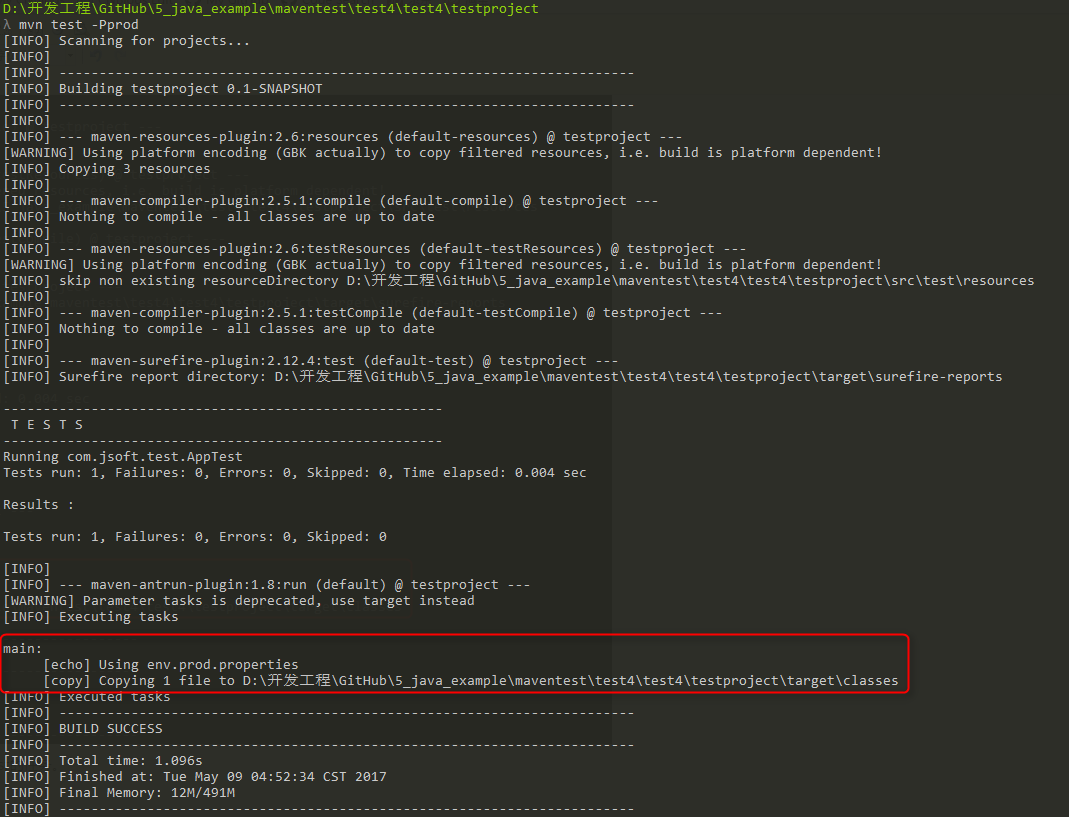
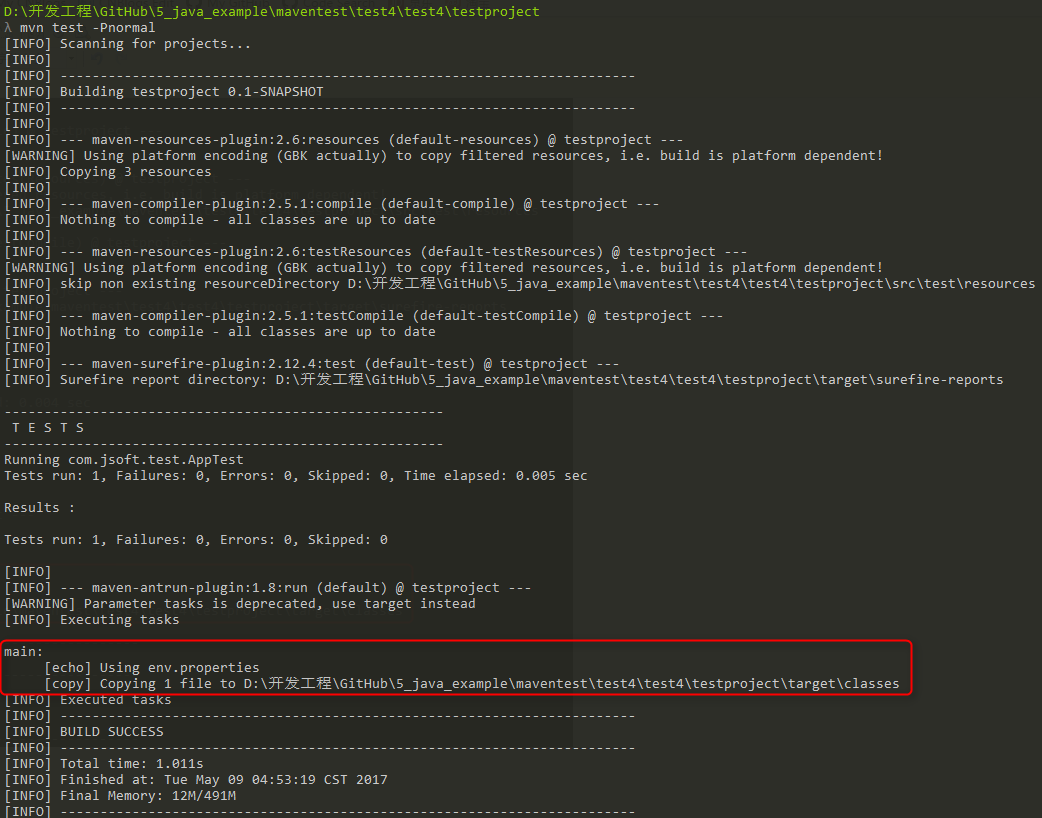
2、通過maven設置激活配置文件
打開 %user_home%/.m2 目錄下的 settings.xml 文件,其中 %user_home% 代表用戶主目錄。如果 setting.xml 文件不存在就直接拷貝 %m2_home%/conf/settings.xml 到 .m2 目錄,其中 %m2_home% 代表 maven 的安裝目錄。
配置 setting.xml 文件,增加 <activeprofiles>屬性:
<settings xmlns="http://maven.apache.org/pom/4.0.0"
xmlns:xsi="http://www.w3.org/2001/xmlschema-instance"
xsi:schemalocation="http://maven.apache.org/pom/4.0.0
http://maven.apache.org/xsd/settings-1.0.0.xsd">
...
<activeprofiles>
<activeprofile>test</activeprofile>
</activeprofiles>
</settings>
執行命令:
mvn test
提示 1:此時不需要使用 -ptest 來輸入參數了,上面的 setting.xml 文件的 <activeprofile> 已經指定了 test 參數代替了。
提示 2:同樣可以使用在 %m2_home%/conf/settings.xml 的文件進行配置,效果一致。
執行結果:

3、通過環境變量激活配置文件
先把上一步測試的 setting.xml 值全部去掉。
然后在 pom.xml 里面的 <id> 為 test 的 <profile> 節點,加入 <activation> 節點:
<project xmlns="http://maven.apache.org/pom/4.0.0" xmlns:xsi="http://www.w3.org/2001/xmlschema-instance"
xsi:schemalocation="http://maven.apache.org/pom/4.0.0 http://maven.apache.org/maven-v4_0_0.xsd">
<modelversion>4.0.0</modelversion>
<groupid>com.jsoft.test</groupid>
<artifactid>testproject</artifactid>
<packaging>jar</packaging>
<version>0.1-snapshot</version>
<name>testproject</name>
<url>http://maven.apache.org</url>
<dependencies>
<dependency>
<groupid>junit</groupid>
<artifactid>junit</artifactid>
<version>3.8.1</version>
<scope>test</scope>
</dependency>
</dependencies>
<profiles>
<profile>
<id>test</id>
<activation>
<property>
<name>env</name>
<value>test</value>
</property>
</activation>
<build>
<plugins>
<plugin>
<groupid>org.apache.maven.plugins</groupid>
<artifactid>maven-antrun-plugin</artifactid>
<version>1.8</version>
<executions>
<execution>
<phase>test</phase>
<goals>
<goal>run</goal>
</goals>
<configuration>
<tasks>
<echo>using env.test.properties</echo>
<copy file="src/main/resources/env.test.properties" tofile="${project.build.outputdirectory}/env.properties" overwrite="true"/>
</tasks>
</configuration>
</execution>
</executions>
</plugin>
</plugins>
</build>
</profile>
<profile>
<id>normal</id>
<build>
<plugins>
<plugin>
<groupid>org.apache.maven.plugins</groupid>
<artifactid>maven-antrun-plugin</artifactid>
<version>1.8</version>
<executions>
<execution>
<phase>test</phase>
<goals>
<goal>run</goal>
</goals>
<configuration>
<tasks>
<echo>using env.properties</echo>
<copy file="src/main/resources/env.properties" tofile="${project.build.outputdirectory}/env.properties" overwrite="true"/>
</tasks>
</configuration>
</execution>
</executions>
</plugin>
</plugins>
</build>
</profile>
<profile>
<id>prod</id>
<build>
<plugins>
<plugin>
<groupid>org.apache.maven.plugins</groupid>
<artifactid>maven-antrun-plugin</artifactid>
<version>1.8</version>
<executions>
<execution>
<phase>test</phase>
<goals>
<goal>run</goal>
</goals>
<configuration>
<tasks>
<echo>using env.prod.properties</echo>
<copy file="src/main/resources/env.prod.properties" tofile="${project.build.outputdirectory}/env.properties" overwrite="true"/>
</tasks>
</configuration>
</execution>
</executions>
</plugin>
</plugins>
</build>
</profile>
</profiles>
</project>
執行命令:
mvn test -denv=test
提示 1:上面使用 -d 傳遞環境變量,其中 env 對應剛才設置的 <name> 值,test 對應<value>。
提示 2:在 windows 10 上測試了系統的環境變量,但是不生效,所以,只能通過 -d 傳遞。
執行結果:
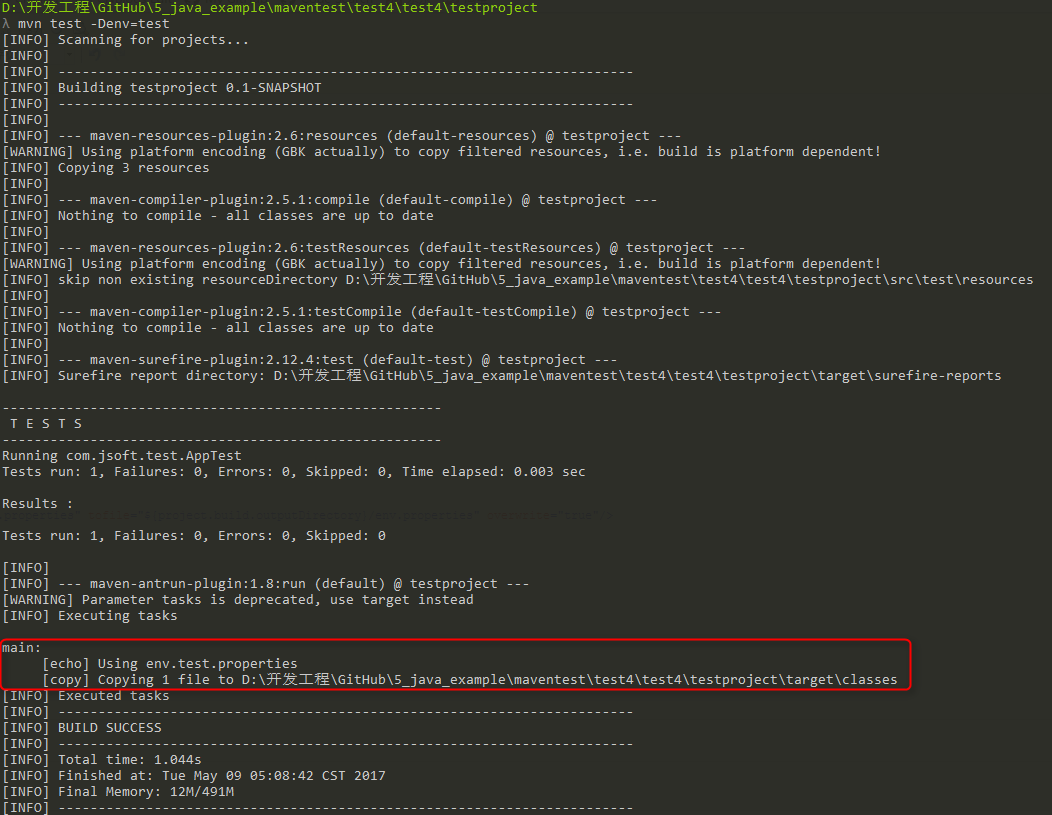
4、通過操作系統激活配置文件
activation 元素包含下面的操作系統信息。當系統為 windows xp 時,test profile 將會被觸發。
<profile>
<id>test</id>
<activation>
<os>
<name>windows xp</name>
<family>windows</family>
<arch>x86</arch>
<version>5.1.2600</version>
</os>
</activation>
</profile>
現在打開命令控制臺,跳轉到 pom.xml 所在目錄,并執行下面的 mvn 命令。不要使用 -p 選項指定 profile 的名稱。maven 將顯示被激活的 test profile 的結果。
mvn test
5、通過文件的存在或者缺失激活配置文件
現在使用 activation 元素包含下面的操作系統信息。當 target/generated-sources/axistools/wsdl2java/com/companyname/group 缺失時,test profile 將會被觸發。
<profile>
<id>test</id>
<activation>
<file>
<missing>target/generated-sources/axistools/wsdl2java/
com/companyname/group</missing>
</file>
</activation>
</profile>
現在打開命令控制臺,跳轉到 pom.xml 所在目錄,并執行下面的 mvn 命令。不要使用 -p 選項指定 profile 的名稱。maven 將顯示被激活的 test profile 的結果。
mvn test
參考:https://www.cnblogs.com/easonjim/p/6828743.html




